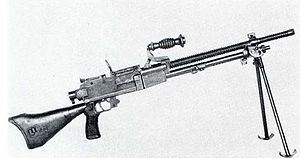Type 96 light machine gun
| Type 96 light machine gun | |
|---|---|

|
|
| general information | |
| Military designation: | Type 96 |
| Country of operation: |
|
| Developer / Manufacturer: | Nambu Kijirō |
| Development year: | 1936 |
| Manufacturer country: |
|
| Production time: | 1936-1945 |
| Weapon Category: | light machine gun |
| Furnishing | |
| Overall length: | 1050 mm |
| Weight: (unloaded) | 9 kg |
| Barrel length : | 688 mm |
| Technical specifications | |
| Caliber : | 6.5 × 50 mm rear |
| Possible magazine fillings : | 30 cartridges |
| Ammunition supply : | Curve magazine |
| Cadence : | 550 rounds / min |
| Fire types: | Continuous fire |
| Number of trains : | 4th |
| Twist : | right |
| Visor : | open sights |
| Closure : | Tilt block closure |
| Charging principle: | air-cooled gas pressure charger |
| Lists on the subject | |
The light machine gun Type 96 ( jap. 九六式軽機関銃 , Kyūroku-shiki kei kikanjū ), even slight Nambu called, is an air-cooled, fully automatic lightweight gas operated - machine gun that from 1936 the Japanese Imperial Army and the Imperial Japanese Marine was on duty. The designation type 96 refers to the year of introduction within the Japanese calendar scheme in the year 2596 - in the Gregorian calendar the year 1936.
development

The Type 96 became the standard IMG of the Imperial Japanese Armed Forces when it was introduced in 1936 . It was a further development of the Type 11 light machine gun , but had some improved features of the Czech ZB vz. 26 taken over such as B. an insertable and replaceable cam magazine and a slightly conical flash hider . After the Type 99, the Type 96 was the second most frequently produced light machine gun in the Japanese Empire with around 41,000 copies .
design

The barrel was ribbed to give stability and to guarantee optimal air cooling. The barrel could be replaced if it overheated. Although the Type 96 could be carried with both hands on the barrel and butt , it also had a handle that was attached roughly in the middle. It was about 2.5 kg lighter than its predecessor and weighed just under 9 kg. Despite the technical revision, it only fired the 6.5 × 50 mm HR ammunition , which during the Second Sino-Japanese War proved to be too weak and was increased to 7.7 mm in the successor Type 99 . By using the Curve magazine and the position change of ammunition oiling mechanism led to lower stoppages than its predecessor.
During the assault , the Type 96 was fired from the hip, the weapon being carried with a shoulder strap. Unusually for a machine gun, the Type 96 had a locking device for the Type 30 bayonet . As with all Japanese MGs, the weapon could only be used in continuous fire . The aiming device was slightly to the left of the barrel. An attachment for a telescopic sight was possible.
literature
- James H. Willbanks: Machine Guns: An Illustrated History of Their Impact .
- David Miller: Fighting Men of World War II, Axis Forces . Uniforms, Equipment & Weapons of Axis Forces. 1st edition. Stackpole Books, 2007, ISBN 978-0-8117-0277-5 , Japan, pp. 281 .
- Philip Warner: Japanese Army of World War II , Osprey Publishing, 2005, ISBN 978-0-8504-5118-4 .
- Philip Jowett: The Japanese Army 1931-45 (1) , Osprey Publishing, 2002, ISBN 978-1-8417-6353-8 .
Web links
- Type 96 Light Machine Gun. Taki's homepage, accessed on July 3, 2015 (English).
- Model 96 (1936) 6.5-mm light machine gun. Handbook on Japanese Military Forces, accessed July 3, 2015 .
- Model 96 (1936). japaneseweapons.net, accessed July 3, 2015 .